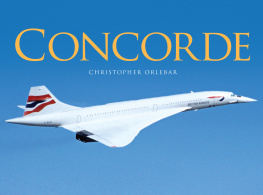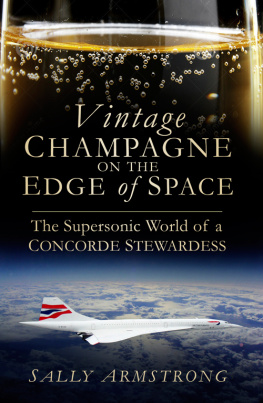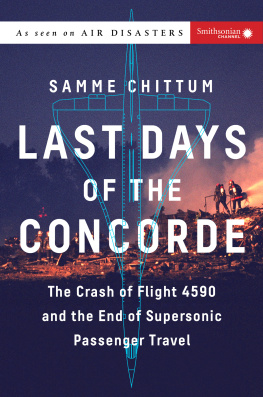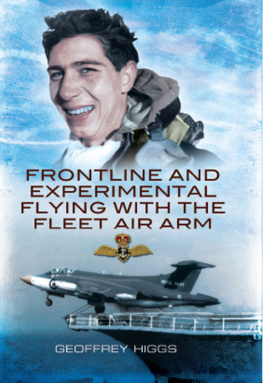G-BOAC. The fineness ratio (length to diameter ratio) must be high to reduce wave drag (caused by the formation of shock waves). Concordes elegance was due to aerodynamic necessity. (John Dibbs/aviation-images.com)
A doctored publicity photo depicting how a formation of four BA Concordes would have appeared in their final livery. In reality Concorde never flew such a formation in these colours. (British Airways)

Concorde 001 in its joint Aerospatiale/BAC livery.
(Photo by Rolls Press/Popperfoto/Getty Images)
The second half of the twentieth century witnessed one of the greatest breakthroughs in civil aviation since the Wright brothers the conquering of flight at speeds faster than sound. The result was the most superlative form of transport yet built by man Concorde, the only successful Super Sonic Transport, or SST. Conceived in 1962, and launched into commercial service in 1976 following 14 years of research and development, Concorde was hailed as one of the great wonders of the technological world. Throughout 27 years of service she was to become an icon of speed and status.
THE PHOTO RECONNAISSANCE SPITFIRE
The theory of supersonic flight that would eventually be applied in the design of Concorde began its development during the Second World War. A number of Allied fighter pilots had experienced strange and dangerous effects when diving at speeds close to that of sound. To preserve frontline fighter pilots and to investigate flight at speeds close to Mach 1 (just below the speed of sound) and to keep ahead of German advances in the new science a series of high speed dives was arranged.
The aircraft chosen for these investigations was the Photo Reconnaissance Spitfire (PR Mark XI) fitted with the Merlin 61 engine. Such a Spitfire was capable of climbing to 40,000ft high even by the standard of the subsonic jets of the 21st century. To achieve the highest speeds the power dive had to be started from as high as possible. Because of this and its relatively thin wings, the Spitfire PR Mark XI was considered a suitable aircraft for research into flight at transonic speed.
Some time in 1943, Squadron Leader Martindale, a test pilot for Rolls-Royce in civilian life, found himself in a 45 degree dive from 40,000ft. After 36 seconds from the start of the dive, descending through 29,000ft, the Spitfire attained Mach 0.9. From about Mach 0.75 upwards some of the airflow became compressed and therefore subject to different aerodynamic laws. The Spitfire experienced increased drag, loss of lift and a tendency to pitch further nose down. Uncorrected, the nose-down pitch would increase the dive angle. To prevent this, the pilot would pull the stick back to apply up elevator. At transonic speeds such action exposed the aircraft to another risk. Due to lack of stiffness in the tailplane and the great force of a compressed airstream on the up-going elevator, the leading edge of the tailplane could bend upwards, leaving the elevator trailing in the slipstream. This resulted in the controls achieving the reverse effect of what was expected, namely pitching the aircraft further nose down. This effect is quite separate from the nose dropping due to the redistribution of the lift.
Entering the warmer atmosphere the Spitfire found itself in an environment where the speed of sound was greater. Although still travelling at roughly the same true airspeed, its speed with respect to the speed of sound (Mach number) was lower. The danger now was that the laws governing the airflow at the slower speeds would suddenly be restored. The up elevator which had maintained the angle of descent could now, at the smaller Mach numbers, reassert itself with unnerving suddenness, pulling the aircraft out of the dive at such a rate that the wings might fold upwards, or flutter like a flag in a stiff breeze. There were no ejection seats in those days.
The Rolls-Royce Merlin 61 engine, which powered the PR XI, had been developed and fitted to the Spitfire Mark IX in response to a formidable new fighter fielded by the Germans in 1941: the Focke-Wulf 190. The increased performance of the Merlin 61 was largely due to the effectiveness of its supercharger. This added 70mph to the top speed and 10,000ft to the Spitfires maximum altitude. In consequence it out-performed the Focke-Wulf 190.
The barrier to greater speed from the Spitfire during its transonic dive was due to two effects. One was the large increase of drag it experienced as the compression waves built up at Mach 0.9; the other was the loss of thrust experienced by the propeller. The combined effect of aircraft forward speed and the turning speed of the propeller ensured that the outer portions of the propeller blades were travelling at supersonic speeds. At such speeds the propeller becomes very inefficient. Thus the Spitfire lost thrust just as its drag increased. A rocket-propelled, rather than a gravity-assisted, Spitfire might have been able to maintain Mach 0.9 for longer.
Rocket propulsion has the advantage over other kinds of propulsion in that the thrust it generates is not dependent on the forward speed of the aircraft. Nor is its thrust dependent on altitude; if anything it increases as the pressure of air around it decreases. Although rocket-propelled aircraft are spared the need for any kind of air intake, they suffer the greater burden of having to carry extra fuel weight in the form of liquid oxygen (or some chemical suitable for combustion with the fuel). They therefore do not give propulsion suitable for sustained flight.
THE SUPERCHARGER
A supercharger is a device that compresses the air before it undergoes further compression in the cylinders of a piston engine. The supercharger on the Merlin 61 engine had been refined to near perfection by a brilliant young engineer at Rolls-Royce in Derby Stanley Hooker. Hookers work on superchargers was soon to have great relevance in the development of the jet engine, since the centrifugal compressors of the early jet engines were similar in principle to, although much larger than, the supercharger of the Merlin. The jet engine turned out to be the most suitable power plant for continuous supersonic flight. Eleven years after his work on the Merlin supercharger, Stanley Hooker began the transformation of the Bristol Olympus engine, destined, in its most outstanding version, to power Concorde.
JET-PROPELLED FLIGHT

The Gloster E28/39, Britains first jet-propelled aircraft, which first flew on 14 May 1941. (Permission of Ian Whittle)
Happily, by 1943 there had appeared an engine which looked capable of giving sustained thrust both at subsonic and supersonic speeds. This was the jet engine. This new engine gave thrust, not through a propeller, but by virtue of its high speed jet efflux. The fact that its intake might be in a supersonic airflow would be, if anything, a bonus, since the incoming air could be slowed down and therefore supercharged prior to entering the compressor on the engine, making the engine yet more efficient.
















